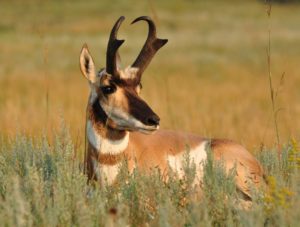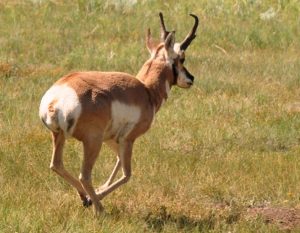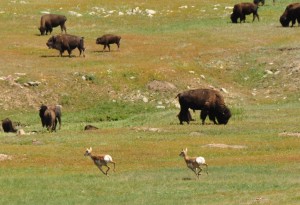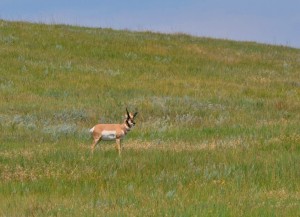Photography courtesy of Lowell Washburn, all rights reserved.
Black Hills pronghorns are known by many names. Most Easterners still call them antelope; they’re not. Most locals refer to them as Speed Goats; still incorrect, though much closer to the truth. But regardless of what you may choose to call it, one thing is certain. The pronghorn is one very amazing creature. Perhaps most amazing is its ability to run. Attaining or exceeding speeds of 50 mph, pronghorns are credited with being the world’s second fastest land animal — its velocity surpassed only by the short range speed burst of the cheetah. If the speed challenge were to ever go long distance, however, the pronghorn would certainly win — hands down. In vivid contrast to the bison they frequently associate with, pronghorns have incredibly sharp, long range vision. Given the right conditions, they can literally see approaching danger from miles away.
For South Dakota pronghorns, danger comes in many forms. Mauarding coyotes are always looking for opportunities to snatch young pronghorns, and I have a video that shows an adult golden eagle as it plummets directly into a stampeding herd of pronghorns and kills a kid. My friend Paul Willis once pulled over at a Wyoming rest stop and heard some nearby rustling in the sage. Moving to investigate, he discovered a golden eagle in the process of devouring a still quivering, freshly killed young pronghorn. Although a resident pair of golden eagles have successfully reared young this summer in a southern part of Custer State Park where I like to sit and watch bison, I have never seen or heard of them making any attacks on pronghorns. Instead, the adults — and now this year’s young — spend much of their time haunting a nearby prairie dog town. I assume the abundant populations of black-tailed prairie dogs — along with the prairie rattlesnakes that also frequent the ‘dog towns — have been more than enough to fulfill the eagle family’s nutritional requirements.

Custer State Park — as well as the Black Hills area in general — also harbors a thriving population mountain lions. There are even enough big cats to provide a limited hunting season, and I saw a photograph of a 125-pound male that Gary Gruber’s son killed near Custer a couple of winters ago. Last winter, a cougar killed and ate a deer on a lawn just two blocks off the main drag in Custer. Although such an event would have caused widespread panic back in the Tall Corn State, local residents dismissed the incident as just a natural part of “living in The Hills”. Although I’m sure cougars would also enjoy dining on “antelope”, I imagine they rarely get the chance given the pronghorn’s legendary speed, eyesight, and its habit of mostly sticking to open country.
Human hunters take their share of pronghorns, and I consider pronghorn meat to be among the very best I’ve ever tasted. At the same time, I also rank it as the worst of the very worst wild game to ever pollute a skillet. After downing a nice Western buck, my friend Steve Schutte invited us over for a couple of Speed Goat dinners. Tender, sweet, and exceedingly flavorful — we all agreed that it was some of the finest food we’d ever enjoyed. Another friend bagged a nice antelope and when we tried to eat it; well, it just couldn’t be done. Both scenarios are common, I’m told, and that it has all to do with game care in the field. Just as quick as a pronghorn is down and kicking, the experts say, you need to get the guts out and the hide off. If you can get the quarters on ice, then so much the better. Spend too much time with photos or with getting the animal back to camp and you’ll end up with something the coyotes will refuse. I’ve not yet had the opportunity to hunt pronghorns with anything but a camera, but I’d love to try and get an arrow into one. I’m seriously thinking of adding the species to my personal Bucket List. “What, you have a Bucket List?,” my friend Ross Dirks — who is several years my junior — recently asked.
“Um, yea, I guess I do,”I replied.
“Well,” Ross chuckled, “then I think if I were you, I’d be getting at it.” Hmmm . . . Point taken!
Attached are photos of some of the pronghorns that I’ve spent time with this month. The annual rut is just beginning in western South Dakota and the animals are really becoming active; some of the bigger bucks are starting to chase. Fun to watch; I still can’t believe how fast they can go!





 Tom Cope
Tom Cope Sue Wilkinson
Sue Wilkinson Susan Judkins Josten
Susan Judkins Josten Rudi Roeslein
Rudi Roeslein Elyssa McFarland
Elyssa McFarland Mark Langgin
Mark Langgin Adam Janke
Adam Janke Joe Henry
Joe Henry Kristin Ashenbrenner
Kristin Ashenbrenner Joe Wilkinson
Joe Wilkinson Dr. Tammy Mildenstein
Dr. Tammy Mildenstein Sean McMahon
Sean McMahon